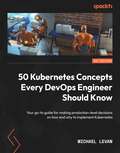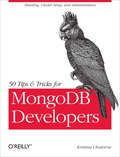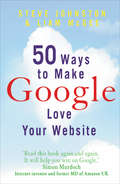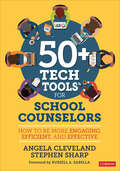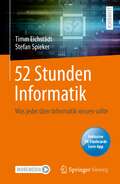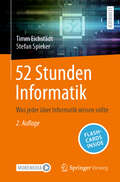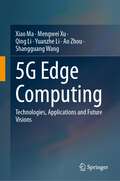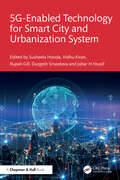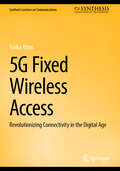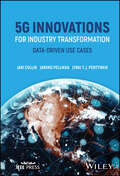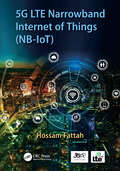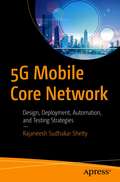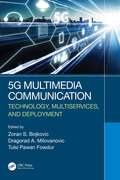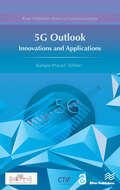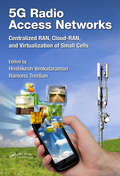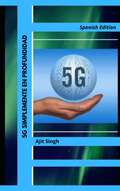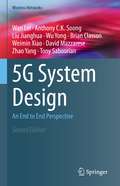- Table View
- List View
50 Digital Ideas You Really Need to Know
by Tom ChatfieldWe are in the throes of a revolution, yet most of us are so disorientated by the rapid pace of technological and cultural change that we find it difficult to understand what's going on. 50 Digital Ideas you Really Need to Know provides a clear path through the confusion and misinformation surrounding those technologies that, for better or for worse, are transforming the world we live in and even the sort of people we are.Leading technology writer Tom Chatfield is a sure-footed guide to the seminal digital phenomena of our time, from the basic browsers that we use to surf the web and update our status on social networking sites, through to the implications for privacy of our permanently distracted world, to the culture jamming that is increasingly being used by protest movements, this is essential reading for anyone who wants to understand the profound social and behavioural changes wrought by the emerging digital age.
50 Digital Ideas You Really Need to Know (50 Ideas You Really Need to Know series)
by Tom ChatfieldWe are in the throes of a revolution, yet most of us are so disorientated by the rapid pace of technological and cultural change that we find it difficult to understand what's going on. 50 Digital Ideas you Really Need to Know provides a clear path through the confusion and misinformation surrounding those technologies that, for better or for worse, are transforming the world we live in and even the sort of people we are.Leading technology writer Tom Chatfield is a sure-footed guide to the seminal digital phenomena of our time, from the basic browsers that we use to surf the web and update our status on social networking sites, through to the implications for privacy of our permanently distracted world, to the culture jamming that is increasingly being used by protest movements, this is essential reading for anyone who wants to understand the profound social and behavioural changes wrought by the emerging digital age.
50 Digital Ideas You Really Need to Know: You Really Need to Know (50 Ideas You Really Need to Know series)
by Tom ChatfieldWe are in the throes of a revolution, yet the rapid pace of technological and cultural change makes it difficult to understand what's going on. 50 Ideas You Really Need to Know: Digital provides a clear path through the misinformation surrounding those technologies that are transforming the world. Leading technology writer Tom Chatfield provides a sure-footed guide to the seminal digital phenomena of our time: from the basic browsers that we use to surf the web, to the implications for our own privacy. From plumbing the depths of the deep web that represents well over 99 per cent of the internet and remains inaccessible to most search engines, to digital distribution that threatens to sweep away entire industries, this is an indispensable road map for our journey to a digital future.(P)2011 Quercus Editions Ltd
50 Kubernetes Concepts Every DevOps Engineer Should Know: Your go-to guide for making production-level decisions on how and why to implement Kubernetes
by Luca Massaron Michael LevanA must-have Kubernetes book to learn key concepts for succeeding in any production environment, be it a greenfield Kubernetes environment or your cloud-native journeyKey FeaturesAdvance in your Kubernetes journey with guidance from a seasoned k8s practitioner and trainerDiscover best practices for implementing Kubernetes in any production environmentGo beyond the basics and work with Kubernetes applications in every environmentBook DescriptionKubernetes is a trending topic among engineers, CTOs, CIOs, and other technically sound professionals. Due to its proliferation and importance for all cloud technologies, DevOps engineers nowadays need a solid grasp of key Kubernetes concepts to help their organization thrive.This book equips you with all the requisite information about how Kubernetes works and how to use it for the best results. You'll learn everything from why cloud native is important to implementing Kubernetes clusters to deploying applications in production. This book takes you on a learning journey, starting from what cloud native is and how to get started with Kubernetes in the cloud, on-premises, and PaaS environments such as OpenShift. Next, you'll learn about deploying applications in many ways, including Deployment specs, Ingress Specs, and StatefulSet specs. Finally, you'll be comfortable working with Kubernetes monitoring, observability, and security. Each chapter of 50 Kubernetes Concepts Every DevOps Engineer Should Know is built upon the previous chapter, ensuring that you develop practical skills as you work through the code examples in GitHub, allowing you to follow along while giving you practical knowledge.By the end of this book, you'll be able to implement Kubernetes in any environment, whether it's an existing environment, a greenfield environment, or your very own lab running in the cloud or your home.What you will learnFind out how Kubernetes works on-premises, in the cloud, and in PaaS environmentsWork with networking, cluster management, and application deploymentUnderstand why cloud native is crucial for Kubernetes applicationsDeploy apps in different states, including Stateless and StatefulMonitor and implement observability in your environmentExplore the functioning of Kubernetes security at the cluster, user, and application levelWho this book is forThis book is for cloud engineers, developers, DevOps engineers, and infrastructure engineers responsible for inheriting a Kubernetes environment or creating a greenfield Kubernetes environment. If you are a professional who wants to get started with cloud-native applications and implement k8s best practices, then this book is a must-read. If you have engineered environments in the cloud and on-premises and understand how to deploy applications with a solid tenure in a developer role, this book will help you further your skills.
50 Tips and Tricks for MongoDB Developers: Get the Most Out of Your Database
by Kristina ChodorowGetting started with MongoDB is easy, but once you begin building applications with it, you'll face some complex issues. What are the tradeoffs between normalized and denormalized data? How do you handle replica set failure and failover? This collection of MongoDB tips, tricks, and hacks helps you resolve issues with everything from application design and implementation to data safety and monitoring.You get specific guidance in five topic areas directly from engineers at 10gen, the company that develops and supports this open source database:Application Design Tips: What to keep in mind when designing your schemaImplementation Tips: Programming applications against MongoDBOptimization Tips: Speeding up your applicationsData Safety Tips: Using replication and journaling to keep data safe—without sacrificing too much performanceAdministration Tips: How to configure MongoDB and keep it running smoothly
50 Top IT Project Management Challenges
by Premanand Doraiswamy Premi ShivA summary of the challenges facing today's IT project managerDiscussions on project management forums highlight many of the challenges facing a project manager during the course of a project. Unclear requirements, scope creep and undefined roles are well-trodden issues that can derail a project. Other challenges are less obvious, often more subtle, but equally destructive. Facing up to the challengesThis book offers a focused and concise summary of 50 challenges facing today's IT project manager. The authors draw on years of practical experience (rather than classroom theory) to outline these challenges and offer useful tips and advice on how to deal with them. Challenge and responseReaders of this book will be better equipped to respond to key project management challenges, includingBuilding the team - getting the right resources, matching skills/knowledge, defining roles and responsibilities. Project scope - clarifying assumptions, avoiding ambiguity, getting the time/cost estimates right. Politics - communicating with management and stakeholders, dealing with conflict, handling interference and micro-managing. Risk awareness - identifying inside/outside influences, recognising inbound and outbound dependencies. Time management - using the right planning tools, balancing work versus meetings. Failure - handling the blame game, protecting the team, rescuing the project. This book condenses into a handy summary much of the information and advice that can be found in project management related books and discussion forums. It is an ideal reference for anyone involved in IT project management, from professional service organisations (PSO) and project management offices (PMO), through to active project managers and studying graduates.
50 Ways to Make Google Love Your Website
by Liam McGee Steve JohnstonGoogle is now a dominant force on the Internet, guiding millions of searches and online purchases every day. Understanding how it works and how to make the most of it is therefore essential to anyone building or running a website, whether for business or as a hobby. This easy-to-follow guide explains not only how Google actually sifts the billions of pages of information its index contains, but shows you how you can improve the performance of your own website in Google's search results, giving specific and detailed instructions about the sort of priority issues you need to address. 50 Ways to Make Google Love Your Website will teach you how to:- Use Google to help you understand how people search for the sort of things you are offering- Create a website that your customers will quickly find in Google- Make your website irresistible to links from other sites- Help Google understand what your site is about- Think like Google and win more traffic
50+ Tech Tools for School Counselors: How to Be More Engaging, Efficient, and Effective
by Angela Cleveland Stephen SharpDigital tools that will transform your practice Educating students in the 21st century is about more than preparing them for work in the digital age; it′s also about connecting with the whole student and transcending barriers. Written for school counselors and other education professionals, 50+ Tech Tools for School Counselors provides insightful descriptions of digital tools that can be used daily to not only enrich intervention and instruction but also guide decision-making, streamline work, enhance communication, and promote happier students. Readers will find: a framework for leadership and advocacy through the lens of technology vignettes demonstrating implementation and quotes from students and other stakeholders step-by-step guides and checklists perspectives from counselors around the country that provide a peer-to-peer feel narratives, technical descriptions, and diagrams School counselors are often unsure or unaware of the myriad of existing tech tools. This book will help them enhance their practice, feel more confident, spend less time on paperwork, and enable today’s students to achieve success in school and access information on college and careers.
50+ Tech Tools for School Counselors: How to Be More Engaging, Efficient, and Effective
by Angela Cleveland Stephen SharpDigital tools that will transform your practice Educating students in the 21st century is about more than preparing them for work in the digital age; it′s also about connecting with the whole student and transcending barriers. Written for school counselors and other education professionals, 50+ Tech Tools for School Counselors provides insightful descriptions of digital tools that can be used daily to not only enrich intervention and instruction but also guide decision-making, streamline work, enhance communication, and promote happier students. Readers will find: a framework for leadership and advocacy through the lens of technology vignettes demonstrating implementation and quotes from students and other stakeholders step-by-step guides and checklists perspectives from counselors around the country that provide a peer-to-peer feel narratives, technical descriptions, and diagrams School counselors are often unsure or unaware of the myriad of existing tech tools. This book will help them enhance their practice, feel more confident, spend less time on paperwork, and enable today’s students to achieve success in school and access information on college and careers.
52 Stunden Informatik: Was jeder über Informatik wissen sollte
by Timm Eichstädt Stefan SpiekerDas Buch vermittelt Allgemeinbildung der Informatik. Alle 52 Lektionen haben einen starken praktischen Bezugzeigen Konzepte/Tools/Technologien auf dem aktuellen Stand der Technikbeschreiben zentrale Begriffe der Informatik mit Erläuterungen, Beispielen, praktischen Übungen, Hinweisen, Diskussionspunkten und weiterführenden Linkssind vom Umfang überschaubar (circa 1 Stunde)Die Priorität liegt auf aktuellen Inhalten und wertvollem Grundlagenwissen mit vielen praktischen Beispielen und Ideen zur Wissensvermittlung. Zusätzlich stehen für Leserinnen und Leser über die Springer Nature Flash-cards-App digitale Lernkarten zum Buch zur Wissenskontrolle und -vertiefung kostenlos zur Verfügung.
52 Stunden Informatik: Was jeder über Informatik wissen sollte
by Timm Eichstädt Stefan SpiekerHaben Sie in Ihrer Schulzeit keinen oder nur mangelhaften Informatikunterricht erhalten? Haben Sie Kinder und würden diese gerne auf das bevorstehende Informationszeitalter vorbereiten? Nehmen Sie sich in den nächsten 52 Wochen je eine Stunde Zeit um mithilfe dieses Buches ein solides Grundwissen über Informatik zu schaffen! 52 Stunden Informatik enthält eine breit gefächerte Zusammenstellung von Lektionen, zum Lernen bzw. Lehren von Grundwissen der Informatik. Vom Nutzen des Internets bis hin zur Informationssicherheit, von deskriptiver Statistik bis hin zum neuronalen Netz sind viele wichtige Aspekte der Informatik abgedeckt. Alle Lektionen enthalten pädagogisch wertvolle Hinweise und sind mit praktischen Übungen versehen. Eine Pflichtlektüre für alle praxisorientierten Informatiklehrer*innen und Eltern, die selbst einen angemessenen Informatikunterricht verpasst haben. Die neue Auflage aktualisiert und erweitert viele Kapitel (z.B. ist das Thema "ChatGPT" im Kapitel über künstliche Intelligenz mit aufgenommen) und enthält ein neues Kapitel über 3D-Druck.
5G Cyber Risks and Mitigation
by Sabhyata Soni5 G technology is the next step in the evolution of wireless communication. It offers faster speeds and more bandwidth than 4G. One of the biggest differences between 4G and 5G is that 5G will be used for a wider range of applications. This makes it ideal for applications such as autonomous vehicles, smart cities, and the internet of things. This means that there will be more devices connected to 5G networks, making them more vulnerable to cyber attacks. However, 5 G also introduces new cyber risks that need to be addressed. In addition, 5 G networks are expected to be much more complex, making them harder to secure. 5G networks will use new technologies that could make them more vulnerable to attack. These technologies include massive MIMO (multiple input, multiple output), which uses more antennas than traditional cellular networks, and millimeter wave (mmWave), which uses higher frequencies than traditional cellular networks. These new technologies could make it easier for attackers to intercept data or disrupt service. To address these concerns, security measures must be implemented throughout the network. Security mechanisms must be included in the design of 5G networks and must be updated as new threats are identified. Moreover, to address these risks, 5 G security standards need to be developed and implemented. These standards should include measures to protect against Denial of Service (DoS) attacks, malware infections, and other threats. Fortunately, artificial intelligence can play a key role in mitigating these risks. With so many interconnected devices, it can be difficult to identify and isolate malicious traffic. AI can help by identifying patterns in data that would otherwise be undetectable to humans. 6G technology is still in the early developmental stages, but security experts are already voicing concerns about the potential challenges that could arise with this next generation of mobile connectivity. Experts are already working on a roadmap for 6G deployment, and they are confident that these and other challenges can be overcome.
5G Edge Computing: Technologies, Applications and Future Visions
by Qing Li Shangguang Wang Ao Zhou Xiao Ma Mengwei Xu Yuanzhe LiEdge computing has been identified as one of the key technologies for 5G networks and beyond due to two prominent advantages: low network latency and reduced core network load. By empowering cloud capabilities and IT service environments at the network edge, edge computing can well support applications of 5G and beyond, such as augmented/virtual reality (AR/VR), vehicular network (ultra-reliable low-latency communication services),Internet of Things (massive machine type communication services), and mobile high-definition video (enhanced mobile broadband services). Therefore, edge computing has attracted the attention of both industry and academia since its emergence. This book highlights the progress of 5G edge computing in both industry and academia according to our long-term efforts, including the current practice of public edge providers, the research process of edge computing from academia, the integration of edge computing with 5G, and the future visions of edge computing in the 6G era. From this book, the readers can benefit from: (1) the first comprehensive measurement study on a leading public edge platform, NEP (next-generation edge platform); 2) a clear and in-depth introduction of the key technologies of 5G edge computing; (3) the latest progress of 5G-integrated edge computing; and (4) pioneering exploration of 6G edge computing based on Tiansuan constellation – an open satellite-terrestrial integrated platform. Both the researchers from academia or practitioners from industry can benefit significantly from this book.
5G Enabled Technology for Smart City and Urbanization System
by Susheela Hooda Durgesh Srivastava Jabar H. Yousif Vidhu Kiran Rupali GillThis book examines the applications, trends and challenges of 5G Enabled technologies for Smart City and Urbanization systems. It addresses the challenges to bringing such capabilities of 5G-enabled technologies for smart cities and urbanisation into practice by presenting the theoretical as well as technical research outcomes with case studies. It covers key areas, including smart building, smart health care, smart mobility, smart living, smart surveillance, and IOT-based systems. It explains how these systems are connected using different technologies that support 5G access and control protocols.• Offers a comprehensive understanding of the emergence of 5G technology and its integration with IoT, Big Data, and Artificial Intelligence for smart city and urbanisation• Focuses on useful applications of Smart City and Urbanization, which can enhance different aspects of urban life• Explores the advantages of using massive IoT and predictive analytics approaches in smart cities• IoT, Bigdata, Deep learning and machine learning techniques are explained to fuel smart city and Urbanization system• Addresses both theoretical and technical research outcomes related to smart city and urbanisation with 5G technology.It serves as a valuable reference for graduate students, researchers, and m practitioners seeking to deepen their knowledge and engage with the latest advancements in the areas of Smart cities and Urbanization systems.
5G Fixed Wireless Access: Revolutionizing Connectivity in the Digital Age (Synthesis Lectures on Communications)
by Isiaka AlimiThis book explores the transformative potential of 5G technology in delivering high-speed broadband services through wireless means, particularly targeting underserved and rural areas. The book covers several key topics, including high-frequency spectrum bands, advanced transmission schemes, multi-connectivity, adaptive numerology, and Integrated Access and Backhaul (IAB). These elements are critical for enhancing network performance, increasing capacity, and reducing latency. High-frequency spectrum bands, such as those above 24 GHz, are essential for providing the necessary bandwidth to support high data rates and capacity. The book explains how these bands, while offering unprecedented peak rates, present challenges such as limited coverage and penetration, which are addressed through advanced technical solutions. Advanced transmission schemes, including massive beamforming and Multiple-Input Multiple-Output, are explored in detail. These technologies enable the efficient use of the spectrum by allowing multiple user terminals to be served simultaneously on the same frequency resources, thereby increasing the overall network capacity and improving user experiences. Multi-connectivity and adaptive numerology are also key topics. Multi-connectivity allows user equipment to connect to multiple network nodes simultaneously, improving reliability and performance. Adaptive numerology, defined in 3GPP Release 15, supports a flexible range of subcarrier spacing to cater to different services, quality of service requirements, latency needs, and frequency ranges. IAB is another significant topic covered in the book. IAB leverages the same spectrum for both access and backhaul, simplifying deployment and reducing costs. By using the 5G infrastructure to support backhaul, it eliminates the need for extensive fiber installations, making it easier to extend high-speed connectivity to remote and rural areas. These topics are crucial as they collectively address the limitations of traditional wired infrastructure, which is often costly and time-consuming to deploy in rural and hard-to-reach areas. By leveraging 5G Fixed Wireless Access (FWA), the book sets out to solve the problem of the digital divide, aiming to make high-speed internet more accessible and affordable. The relevance of these solutions is underscored by the growing global demand for reliable, high-speed internet access. As the book outlines, 5G FWA not only enhances broadband services but also plays a pivotal role in bridging the digital divide, ensuring that more people, regardless of their location, can benefit from the advancements in internet technology. This makes "5G FWA " an essential read for understanding the future of broadband connectivity and the strategic approaches needed to overcome deployment challenges. This book is intended to be a definitive guide for professionals, researchers, policymakers, and anyone interested in understanding the nuances and implications of this transformative technology.
5G Innovations for Industry Transformation: Data-driven Use Cases
by Jyrki T. Penttinen Jari Collin Jarkko Pellikka5G INNOVATIONS FOR INDUSTRY TRANSFORMATION Authoritative resource providing insight on real-life industrial 5G use cases in driving customer value, productivity, and sustainability ambitions With 5G innovations rapidly expanding to different areas within technology, 5G Innovations for Industry Transformation provides key information on how 5G technology can positively impact digital transformation in the industry sectors, discussing new data-driven business opportunities, including green digital transition, new standards for sustainability, and real-time data-driven services, introducing case studies that cover a variety of industries, from the oil & gas industry to the telecom industry, along with the lessons learned from these case studies, and providing insights into how 5G technology will transform businesses by sharing real-time customer solutions, fair data sharing principles, and ecosystem and change management. The book summarizes novelty aspects in a compact and practical way to benefit users and specialists in the field who want to understand some of the very key aspects of 5G. To aid in reader comprehension, the book contains tables, figures of technical principles and architectural block diagrams, and photographs further explaining key topics. Sample topics covered in 5G Innovations for Industry Transformation include: 5G SA technology with new capabilities, 5G private networks, and how smart, connected products are transforming competition Implications of 5G applied to your particular business and/or industry, and how to scale up and industrialize based on these implications How to lead the charge in relation to optimizing business practices based on the advent of 5G, and details on navigating the platform economy How 5G affects data privacy and security, and other integrated capabilities of 5G, such as processes, data, technology, and competencies Based on real-world experiences and high-quality research and presenting practical examples that serve as a useful guiding hand, 5G Innovations for Industry Transformation is an essential resource for change leaders, enterprise architects, and software developers of any industrial enterprise seeking to drive digitalization forward in their value chain and organization.
5G LTE Narrowband Internet of Things (NB-IoT)
by Hossam FattahThis book explains the 3GPP technical specifications for the upcoming 5G Internet of Things (IoT) technology based on latest release which is Release 15. It details the LTE protocol stack of an IoT device, architecture and framework, how they are functioning and communicate with cellular infrastructure, and supported features and capability. NB-IoT is designed to connect a large number of devices in a wide range of application domains forming so-called Internet of Things (IoT). Connected devices are to communicate through cellular infrastructure. This technology is new within the 3GPP specifications and is part of upcoming new wireless technology known as 5G. Table of Contents Preface. Acknowledgments. Author. List of Abbreviations. 1. Internet of Things. 2. 4G and 5G Systems. 3. Radio Resource Control Sublayer. 4. Packet Data Convergence Protocol Sublayer. 5. Radio Link Control Sublayer. 6. Medium Access Control Sublayer. 7. Physical Sublayer. 8. Quality of Service Architecture. 9. Use Cases and Deployment. References. Index.
5G Mobile Core Network: Design, Deployment, Automation, and Testing Strategies
by Rajaneesh Sudhakar ShettyGet up to speed on 5G and prepare for the roll out of the next generation of mobile technology. The book begins with an introduction to 5G and the advanced features of 5G networks, where you’ll see what makes it bigger, better, and faster. You will learn 5G NSA and SA packet core design along with some design challenges, taking a practical approach towards design and deployment. Next, you will understand the testing of the 5G packet core and how to automate it. The book concludes with some advanced service provider strategies, including architectural considerations for service providers to enhance their network and provide services to non-public 5G networks.5G Mobile Core Network is intended for those who wish to understand 5G, and also for those who work extensively in a service provider environment either as operators or as vendors performing activities such as network design, deployment, testing, and automation of the network. By the end of this book you will be able to understand the benefits in terms of CAPEX and OPEX while considering one design over another. Consulting engineers will be able to evaluate the design options in terms of 5G use cases, the scale of deployment, performance, efficiency, latency, and other key considerations. What You Will Learn Understand the life cycle of a deployment right from pre-deployment phase to post-deployment phaseSee use cases of 5G and the various options to design, implement, and deploy themExamine the deployment of 5G networks to large-scale service providersDiscover the MVNO/MVNE strategies that a service provider can implement in 5GWho This Book Is For Anyone who is curious about 5G and wants to learn more about the technology.
5G Multimedia Communication: Technology, Multiservices, and Deployment
by Zoran S. Bojkovic, Dragorad A. Milovanovic, and Tulsi Pawan FowdurIn bringing to the readers the book 5G Multimedia Communication: Technology, Multiservices and Deployment, the aim is to present current work and direction on the challenging subject of multimedia communications, with theoretical and practical roots. The past two decades have witnessed an extremely fast evolution of mobile cellular network technology. The fifth generation of mobile wireless systems has achieved the first milestone toward finalization and deployment by 2020. This is vital to the development of future multimedia communications. Also, it is necessary to consider 5G technology from the performance point of view by analyzing network capabilities to the operator and to the end user in terms of data rate, capacity, coverage, energy efficiency, connectivity and latency. The book is divided into three major parts with each part containing four to seven chapters: • Critical enabling technology • Multiservices network • Deployment scenarios The first part discusses enabling technologies, such as green communication, channel modeling, massive and distributed MIMO and ML-based networks. In the second part, different methodologies and standards for multiservices have been discussed. Exclusive chapters have been dedicated to each of the open research challenges such as multimedia operating in 5G environment, network slicing optimization, mobile edge computing, mobile video multicast/broadcast, integrated satellite and drone communication. The third part paved the way to deployment scenarios for different innovative services including integration of a multienergy system in smart cities, intelligent transportation systems, 5G connectivity in the transport sector, healthcare services, 5G edge-based video surveillance and challenges of connectivity for massive IoT in 5G and beyond systems. The book is written by experts in the field who introduced scientific and engineering concepts, covering the 5G multimedia communication areas. The book can be read cover-to-cover or selectively in the areas of interest for the readers. Generally, the book is intended for novel readers who could benefit from understanding general concepts, practitioners who seek guidance into the field and senior-level as well as graduate-level engineering students in understanding the process of today’s wireless multimedia communications.
5G Networks: An Overview of Architecture, Design, Use Cases and Deployment
by Atahar Khan Satya Priyo Dhar Ramakrishnan Shanmugasundaram Joe ChemparathyThis book provides comprehensive coverage of building an end-to-end view on how to architect, design, and orchestrate a 5G capable network that will integrate with 5G RAN, IP transport, datacenters, Telco Cloud, and 5G packet networks. It contains real-world examples with challenges and success strategies for deploying 5G Transport with closed-loop automation. It also focuses on aspects like scale, performance, latency, security, and manageability while building 5G transport for some of the world's largest 5G networks as well as migration approaches from 4G to 5G transport and core network.5G is an emerging technology that mobile service providers (MNO/MVNO) across the world are embracing. They are willing to invest in enabling their infrastructure for 5G and explore new business opportunities with their enterprise/mobile customers. As per the Gartner survey, the majority of communication service provider (CSP) revenue will come from 5G.5G is going to open the door to new applications such as wireless virtual reality, low latency machine-to-machine communication, smart city infrastructure, autonomous vehicles, IoT deployment, artificial intelligence-based applications, industrial automation and so much more.
5G New Radio Non-Orthogonal Multiple Access
by Yifei Yuan Zhifeng YuanThis book provides detailed descriptions of downlink non-orthogonal multiple transmissions and uplink non-orthogonal multiple access (NOMA) from the aspects of majorly used 5G new radio scenarios and system performance. For the downlink, the discussion focuses on the candidate schemes in 3GPP standards which are not only applicable to unicast services but also to broadcast/multicast scenarios. For the uplink, the main target scenario is massive machine-type communications where grant-free transmission can reduce signaling overhead, power consumption of devices and access delays. The design principles of several uplink NOMA schemes are discussed in-depth, together with the analysis of their performances and receiver complexities. Devoted to the basic technologies of NOMA and its theoretical principles, data analysis, basic algorithms, evaluation methodology and simulation results, this book will be an essential read for researchers and students of digital communications, wireless communications engineers and those who are interested in mobile communications in general.
5G Outlook – Innovations and Applications: Innovations And Applications (River Publishers Series In Communications Ser.)
by Ramjee Prasad5G Outlook - Innovations and Applications is a collection of the recent research and development in the area of the Fifth Generation Mobile Technology (5G), the future of wireless communications. Plenty of novel ideas and knowledge of the 5G are presented in this book as well as divers applications from health science to business modeling. The authors of different chapters contributed from various countries and organizations. The chapters have also been presented at the 5th IEEE 5G Summit held in Aalborg on July 1, 2016. The book starts with a comprehensive introduction on 5G and its need and requirement. Then millimeter waves as a promising spectrum to 5G technology is discussed. The book continues with the novel and inspiring ideas for the future wireless communication usage and network. Further, some technical issues in signal processing and network design for 5G are presented. Finally, the book ends up with different applications of 5G in distinct areas. Topics widely covered in this book are: • 5G technology from past to present to the future• Millimeter- waves and their characteristics• Signal processing and network design issues for 5G• Applications, business modeling and several novel ideas for the future of 5G
5G Radio Access Networks: Centralized RAN, Cloud-RAN and Virtualization of Small Cells
by Ramona Trestian Hrishikesh VenkatarmanC-RAN and virtualized Small Cell technology poses several major research challenges. These include dynamic resource allocation, self-configuration in the baseband pool, high latency in data transfer between radio unit and baseband unit, the cost of data delivery, high volume of data in the network, software networking aspects, potential energy savings, security concerns, privacy of user’s personal data at a remote place, limitations of virtualized environment, etc. This book provides deeper insights into the next generation RAN architecture and surveys the coexistence of SDN, C-RAN and Small Cells solutions proposed in the literature at different levels.
5G Simplemente en Profundidad
by Ajit Singh5G Technologies es una visión y definición de la Tecnología 5G es introducida, así como varias técnicas clave que permiten la Tecnología 5G. Este libro provee un panorama de las características clave de la quinta Generación (5G) de redes móviles, discutiendo la motivación para 5G, arquitectura, implementación, modelos de referencia, retos en el desarrollo de esta nueva tecnología. Este libro provee una vista dentro de las áreas clave de desarrollo que definirán este nuevo sistema tecnológico, preparando la ruta a través de investigación futura y desarrollo. Este libro pretende cubrir el panorama 5G, incluyendo Internet Futuro, computación en nube, celdas pequeñas y redes auto-organizadas (SONs), comunicaciones cooperativas, y radio cognitivo, convergencia radio difusión-banda ancha, retos de seguridad 5G. Facilidades clave: • Aborda los fundamentales de redes móviles 5G, sirviendo como una guía de estudio para investigadores e ingenieros de sistemas móviles con el objetivo de posicionar su investigación en este escenario de rápida evolución. • Desarrolla la historia de celdas pequeñas junto con la nueva generación de sistemas SON (redes auto-organizadas) como soluciones para dirigir la demanda de tráfico sin precedente y variaciones a través de celdas. • Explica la tecnología de Nube Móvil y Servicios par plataformas futuras de comunicación. • Discute los temas abiertos encarando la implementación a escala comercial amplia de redes de espacio blanco, incluyendo el potencial para aplicaciones hacia el estándar futuro de 5G. • Describe los componentes clave, tendencias y retos, así como los requerimientos de sistemas para transceivers de 5G a radios de soporte multi estándar, una fuente de inspiración por los ingenieros de RF. Este libro serviría como una guía ideal para B.E., B.Tech., B.S., B.Sc, B.C.A., estudiantes univers
5G System Design: An End to End Perspective (Wireless Networks)
by Wan Lei Liu Jianghua Wu Yong Brian Classon Weimin Xiao David Mazzarese Zhao Yang Tony Saboorian Anthony C.K. SoongThis book presents a detailed pedagogical description of the 5G commercial wireless communication system design, from an end to end perspective, by those that were intimate with its development. The exposition only assumes that the reader is passingly familiar with LTE and builds upon that knowledge. By comparing and contrasting NR with LTE, it allows for quick mastering of 5G. As such it gives concise and highly accessible description of the key technologies in the 5G physical layer, radio access network layer protocols and procedures, how the 5G core and EPC is integrated into the radio access network, how virtualization, slicing and edge computer will fundamentally change the way we interact with the network, as well as 5G spectrum issues.The 2nd edition of this book significantly enhances and updates the first edition by adding 5G security and Release-16 developments. Loosely speaking, 5G Release-15 can be characterized as being optimized for the cellular carrier eMBB service while 5G Release-16 is the beginning of the optimization of 5G for the vertical industries. It mainly focused on the support of the vehicular vertical and Industrial Internet of Things. As such, we have significantly altered the first edition to cover the key features standardized in Release-16 including: URLLC, V2X, IIoT, enhanced MIMO, unlicensed access, positioning, power savings and IAB. On the network side, detailed discussion covers NR security as well as the newly standardized access traffic steering, non 3GPP access switching and splitting features, non 3GPP access network support and private networks.Engineers, computer scientists and professionals from those with a passing knowledge of 4G LTE to experts in the field will find this book to be a valuable asset. They will gain a comprehensive understanding of the end to end 5G commercial wireless system. Advanced-level students and researchers studying and working in communication engineering, who want to gain an understanding of the 5G system (as well as methodologies to evaluate features and technologies intended to supplement 5G) will also find this book to be a valuable resource.


